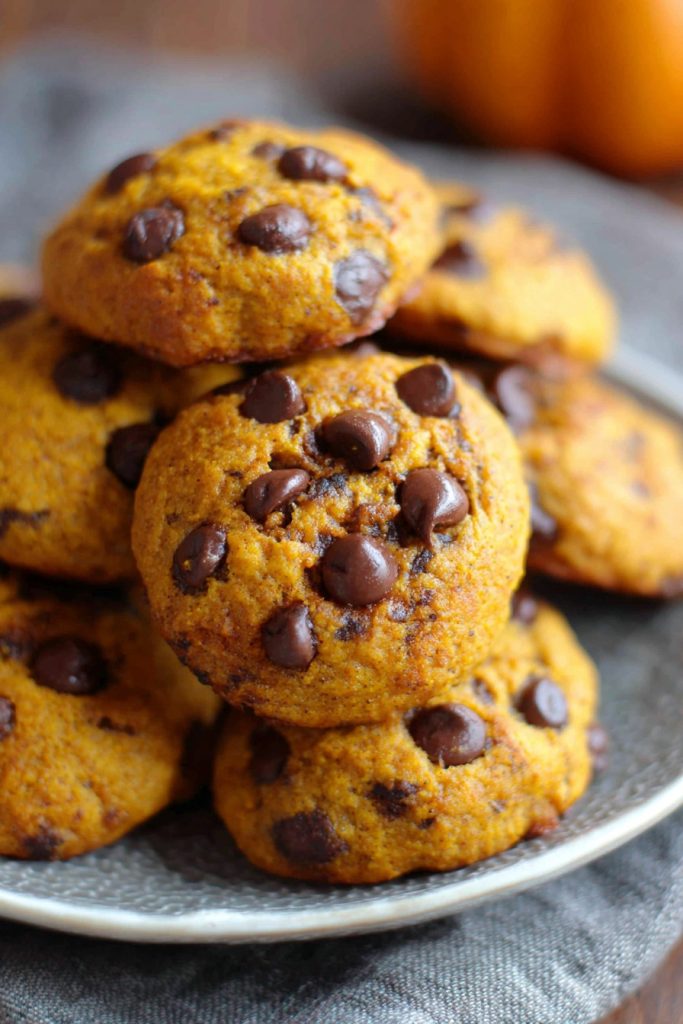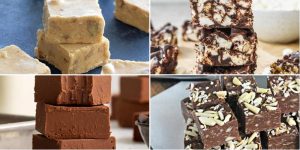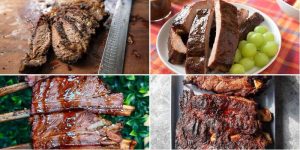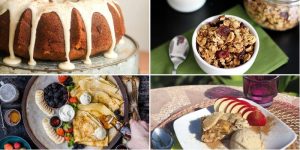Beyond the bustling spice markets of Morocco and the cozy bakeries of rural France lies a cookie that captures autumn’s soul. Blending the earthy sweetness of North American pumpkins with the universal comfort of chocolate, these pumpkin chip cookies weave together culinary traditions across continents in a single, irresistible treat that warms both kitchen and heart. Each bite transports you through global spice routes while maintaining that classic American cookie jar appeal.
Why This Recipe Works
- The combination of pumpkin puree and warm spices creates a moist, cake-like texture reminiscent of traditional European spice cakes while incorporating the distinct autumnal flavors celebrated in North American harvest traditions
- Using both brown and white sugars provides the perfect balance of deep molasses notes and crystalline sweetness that caramelizes beautifully during baking, creating a cookie with complex flavor layers that would feel at home in any Parisian patisserie
- The addition of chocolate chips introduces a luxurious element that contrasts beautifully with the warm spices, much like the chocolate-spice pairings found in Mexican mole sauces or Austrian Sachertorte
- Chilling the dough ensures the cookies maintain their shape while baking, preventing excessive spreading and creating that perfect soft-centered texture that cookie lovers across cultures cherish
- The blend of cinnamon, nutmeg, and ginger creates an aromatic profile that echoes the spice markets of Istanbul while delivering that familiar comfort of American holiday baking traditions
Ingredients
- 2 ¼ cups all-purpose flour, carefully measured using the spoon-and-level method
- 1 teaspoon baking soda, fresh and properly stored to ensure maximum leavening power
- ½ teaspoon baking powder, aluminum-free for cleaner flavor
- 1 teaspoon ground cinnamon, preferably freshly ground for optimal aroma
- ½ teaspoon ground nutmeg, freshly grated if possible for superior flavor complexity
- ¼ teaspoon ground ginger, adding subtle warmth without overwhelming heat
- ½ teaspoon salt, fine sea salt to balance the sweetness
- 1 cup unsalted butter, softened to room temperature (about 65°F)
- ¾ cup granulated sugar, providing clean sweetness and structure
- ¾ cup packed light brown sugar, adding moisture and caramel notes
- 1 large egg, at room temperature for proper emulsion
- 1 teaspoon pure vanilla extract, high-quality for best flavor
- 1 cup pumpkin puree, not pumpkin pie filling, thoroughly drained of excess moisture
- 2 cups semi-sweet chocolate chips, high-quality for superior melting properties
Equipment Needed
- Stand mixer or electric hand mixer
- Large and medium mixing bowls
- Measuring cups and spoons
- Whisk and rubber spatula
- Baking sheets
- Parchment paper or silicone baking mats
- Wire cooling rack
- Cookie scoop (optional but recommended)
Instructions
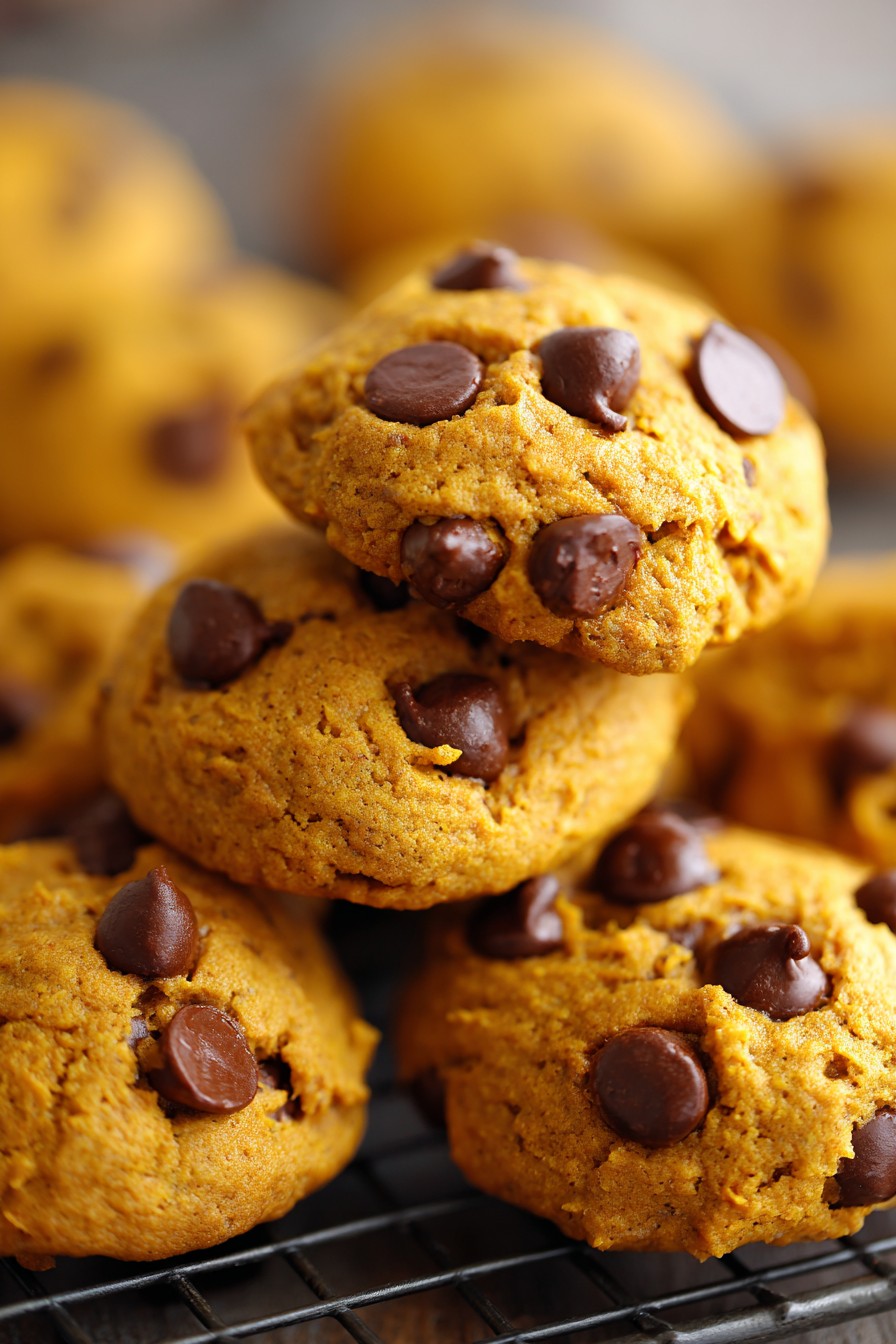
Prepare the Dry Ingredients
In a medium mixing bowl, whisk together 2 ¼ cups all-purpose flour, 1 teaspoon baking soda, ½ teaspoon baking powder, 1 teaspoon ground cinnamon, ½ teaspoon ground nutmeg, ¼ teaspoon ground ginger, and ½ teaspoon salt. This careful blending of spices creates the foundational flavor profile that echoes the aromatic complexity found in Middle Eastern spice blends while ensuring even distribution throughout the dough. The cinnamon brings warmth reminiscent of Mexican canela, the nutmeg adds depth like in Dutch speculaas, and the ginger provides subtle heat that complements the pumpkin’s earthiness. Whisk for at least 30 seconds to aerate the mixture and break up any lumps, creating a uniform base that will incorporate smoothly into the wet ingredients. This step is crucial for achieving consistent texture and flavor in every cookie, much like the precise measurements in French patisserie.
Cream Butter and Sugars
In the bowl of a stand mixer fitted with the paddle attachment, combine 1 cup softened unsalted butter, ¾ cup granulated sugar, and ¾ cup packed light brown sugar. Beat on medium speed for 3-4 minutes until the mixture becomes light, fluffy, and pale in color, scraping down the sides of the bowl halfway through. This creaming process incorporates air into the dough, creating the delicate crumb structure that makes these cookies so tender. The brown sugar adds moisture and caramel notes that complement the pumpkin’s natural sweetness, while the white sugar provides structure and spread. The transformation from separate ingredients to a cohesive, aerated mixture is reminiscent of the careful emulsion techniques used in European buttercreams, where texture is as important as flavor. Continue beating until the mixture nearly doubles in volume and no sugar granules remain visible.
Incorporate Wet Ingredients
Add 1 large room-temperature egg and 1 teaspoon pure vanilla extract to the creamed butter mixture, beating on medium speed until fully incorporated, about 1 minute. Then add 1 cup well-drained pumpkin puree, mixing just until combined. The pumpkin should be thoroughly drained by placing it in a fine-mesh strainer and pressing out excess liquid with a spoon—this prevents the cookies from becoming too cakey or dense. The pumpkin adds not only flavor but also natural moisture and beautiful orange hue, much like the squash used in traditional Italian tortelli di zucca. Scrape down the sides of the bowl to ensure even mixing, being careful not to overmix at this stage. The mixture may appear slightly curdled at first but will become smooth as you continue mixing.
Combine Wet and Dry Mixtures
With the mixer on low speed, gradually add the flour and spice mixture to the wet ingredients, mixing just until the flour disappears and no dry streaks remain. This gentle incorporation prevents overmixing, which would develop gluten and make the cookies tough rather than tender. The dough will be quite soft at this stage—this is normal and expected with pumpkin cookie dough. Then, using a rubber spatula, gently fold in 2 cups semi-sweet chocolate chips until evenly distributed throughout the dough. The chocolate chips should be high-quality for optimal melting and flavor, creating pockets of rich chocolate that contrast beautifully with the spiced pumpkin base, much like the chocolate-orange combinations found in Spanish desserts.
Chill the Dough
Cover the bowl with plastic wrap and refrigerate the dough for at least 1 hour, or up to 24 hours. This chilling period is essential for several reasons: it allows the flour to fully hydrate, develops the flavors as the spices meld together, and firms up the butter to prevent excessive spreading during baking. The chilled dough will be easier to scoop and will produce cookies with better texture and shape. This resting period mirrors the techniques used in French pastry, where patience yields superior results. If chilling longer than 2 hours, you may need to let the dough sit at room temperature for 15-20 minutes before scooping.
Scoop and Bake
Preheat your oven to 350°F and line baking sheets with parchment paper or silicone baking mats. Using a 2-tablespoon cookie scoop or two spoons, portion the chilled dough onto prepared sheets, spacing them about 2 inches apart to allow for spreading. The cookies won’t spread as much as traditional chocolate chip cookies due to the pumpkin content, but proper spacing ensures even baking and browning. Bake for 12-14 minutes, rotating the sheets halfway through, until the edges are lightly golden and the centers appear set but still soft. The cookies will continue to firm up as they cool, so avoid overbaking. The finished cookies should have a cake-like texture with slightly crisp edges.
Cool and Serve
Remove the baking sheets from the oven and let the cookies cool on the sheets for 5 minutes before transferring them to wire racks to cool completely. This resting period on the hot baking sheet allows the cookies to finish setting up without becoming too dry. The aroma filling your kitchen will be reminiscent of autumn markets from New England to the English countryside. Once completely cooled, store the cookies in an airtight container at room temperature for up to 5 days. For optimal texture, place a slice of bread in the container to maintain moisture—a trick borrowed from professional bakers worldwide. These cookies actually improve in flavor after 24 hours as the spices continue to develop.
Tips and Tricks
For truly exceptional pumpkin chip cookies that capture global baking excellence, consider these advanced techniques. When measuring flour, always use the spoon-and-level method rather than scooping directly from the container, as compacted flour can lead to dense, dry cookies—this precision mirrors the exact measurements valued in German baking traditions. For enhanced spice complexity, consider toasting whole spices and grinding them yourself; toast cinnamon sticks, whole nutmeg, and ginger pieces in a dry skillet until fragrant, then grind finely. This releases essential oils that pre-ground spices lose over time, creating aroma profiles similar to those found in Indian masala chai. For chocolate lovers seeking a more sophisticated flavor, use a combination of semi-sweet chunks and milk chocolate chips, or even incorporate chopped dark chocolate with 70% cacao content for bittersweet notes that contrast beautifully with the sweet pumpkin. If your pumpkin puree seems particularly watery, spread it on a paper towel-lined plate and let it drain for 30 minutes before using—this extra step prevents soggy cookies and ensures proper texture. For professional-looking cookies that would rival any Belgian chocolatier’s creations, reserve a handful of chocolate chips to press into the tops of the scooped dough balls before baking, creating visually appealing chocolate pools on the surface. When baking multiple sheets at once, rotate them front-to-back and top-to-bottom halfway through baking to ensure even browning, a technique borrowed from commercial bakeries. For cookies with chewier edges and softer centers, slightly underbake by 1-2 minutes and let them cool completely on the baking sheet. If you prefer crispier cookies, extend baking time by 2-3 minutes and transfer immediately to cooling racks. For flavor development that echoes aged fruitcakes, consider refrigerating the dough for 24-48 hours, allowing the spices to meld and mature into more complex flavor profiles. Always use room temperature ingredients unless specified otherwise, as this ensures proper emulsion and texture development crucial to fine pastry work across European baking traditions.
Recipe Variations
- For a taste of Italian dolci, replace the chocolate chips with white chocolate chunks and add ½ cup chopped toasted pine nuts, creating a sophisticated combination that echoes the flavors of northern Italian baking while maintaining the autumn spice profile
- Channel the flavors of German lebkuchen by adding ¼ cup finely chopped crystallized ginger and replacing the semi-sweet chips with dark chocolate chunks, then dust the cooled cookies with powdered sugar for a festive appearance that bridges European holiday traditions
- Create a Mexican-inspired version by adding 1 teaspoon orange zest and ½ teaspoon ancho chili powder to the dough, then using a combination of semi-sweet chocolate and cinnamon chips for a sweet-heat combination that celebrates the complex flavors of Mexican chocolate
- For a Middle Eastern twist, replace the chocolate chips with 1 cup chopped dates and ½ cup toasted walnuts, then add ¼ teaspoon cardamom to the spice mix, creating cookies that would feel at home in a Moroccan tea service
- Embrace Caribbean flavors by adding ½ cup shredded coconut and ¼ teaspoon allspice to the dough, then dipping half of each cooled cookie in melted dark chocolate for an elegant presentation that combines tropical and autumnal elements
Frequently Asked Questions
Can I use fresh pumpkin instead of canned puree?
Absolutely, and doing so connects you to traditional cooking methods from Central America where pumpkins originated. To use fresh pumpkin, select a small sugar pumpkin (not a carving pumpkin), cut it in half, remove seeds, and roast cut-side down at 400°F for 45-60 minutes until tender. Scoop out the flesh and puree in a food processor until smooth, then drain thoroughly in a cheesecloth-lined strainer for several hours. Fresh pumpkin may have slightly more variable moisture content than canned, so adjust flour if needed—the dough should be soft but not sticky. The flavor difference is subtle but noticeable, with fresh pumpkin offering brighter, more complex notes that European bakers would appreciate.
Why did my cookies turn out cakey instead of chewy?
The cakey texture comes from the natural moisture in pumpkin puree combined with the chemical leaveners, creating a tender crumb similar to European spice cakes. For chewier cookies, ensure your pumpkin is thoroughly drained—spread it on paper towels and press gently to remove excess liquid. You can also reduce the baking powder to ¼ teaspoon and increase the brown sugar to 1 cup while decreasing white sugar to ½ cup, as brown sugar’s molasses content promotes chewiness. Additionally, chilling the dough for at least 2 hours helps develop texture, and slightly underbaking (removing when centers still look moist) preserves chewiness as they cool, much like French financiers maintain their distinctive texture.
Can I make these cookies gluten-free?
Yes, and doing so allows you to explore the diverse world of alternative flours used across global culinary traditions. Replace the all-purpose flour with 2 ¼ cups of a 1:1 gluten-free baking blend that includes xanthan gum. For best results, add 1 tablespoon cornstarch to help tenderize the cookies, and consider using almond flour for ¼ of the total flour amount to add richness reminiscent of Italian amaretti. The cookies may spread slightly more and have a more delicate crumb, so handle them carefully when transferring. Allow them to cool completely on the baking sheet to set properly, as gluten-free baked goods often benefit from extended cooling times.
How should I store these cookies to maintain freshness?
Proper storage techniques reflect the wisdom of bakers worldwide who understand ingredient preservation. Store completely cooled cookies in an airtight container at room temperature with a slice of bread—the bread absorbs excess moisture while keeping the cookies soft, a technique borrowed from professional European bakeries. For longer storage, freeze the baked cookies in a single layer on a baking sheet before transferring to freezer bags, where they’ll keep for 3 months. Alternatively, you can freeze the portioned dough balls and bake directly from frozen, adding 1-2 minutes to the baking time. This method allows you to enjoy fresh-baked cookies anytime, much like Parisian boulangeries that bake throughout the day.
Can I reduce the sugar in this recipe?
While sugar provides structure and moisture in baking, you can moderately reduce it while maintaining quality, adapting the recipe to different cultural preferences for sweetness. Reduce both sugars by ¼ cup total, but no more, as sugar contributes to spreading and texture. The cookies will be slightly less sweet and may spread less, creating a denser texture closer to English biscotti. For those preferring even less sweetness, replace ½ cup of chocolate chips with toasted nuts, which provide texture without added sugar. Remember that sugar acts as a preservative, so reduced-sugar cookies may stale faster—store them properly and consume within 3 days for optimal freshness.
Summary
These pumpkin chip cookies beautifully bridge global culinary traditions, combining American comfort with international spice sophistication. The moist, spiced base complements rich chocolate in a treat that satisfies across cultures while celebrating autumn’s bounty. Perfect for sharing or savoring alone, they represent the universal language of baked goodness.
Pumpkin Chip Cookies
6
servings20
minutes13
minutesIngredients
Instructions
- 1 Whisk flour, baking soda, baking powder, spices, and salt in medium bowl
- 2 Cream butter and sugars until light and fluffy, 3-4 minutes
- 3 Beat in egg, vanilla, and drained pumpkin until combined
- 4 Gradually mix in dry ingredients, then fold in chocolate chips
- 5 Chill dough for at least 1 hour
- 6 Scoop onto parchment-lined sheets and bake at 350°F for 12-14 minutes
- 7 Cool on sheets for 5 minutes before transferring to wire racks
